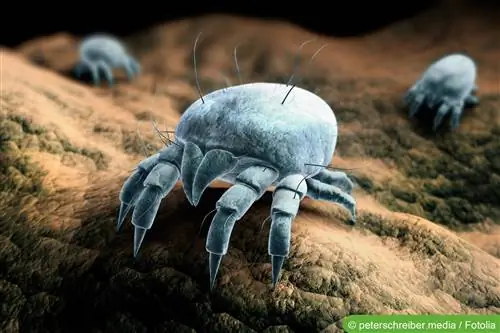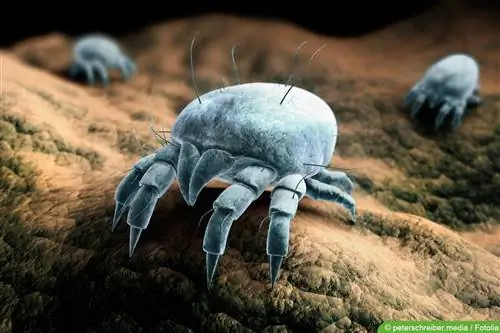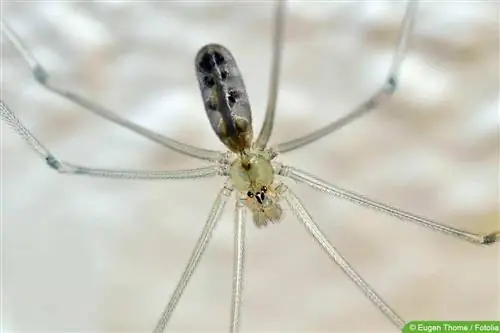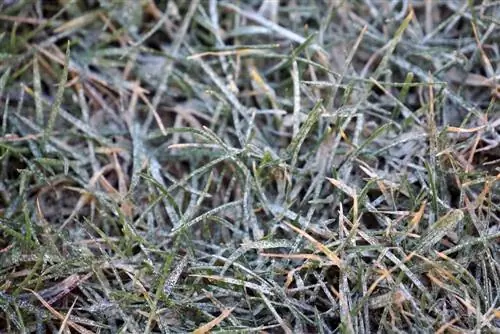- Author admin [email protected].
- Public 2023-12-17 03:39.
- Last modified 2025-01-24 12:45.
House dust mites are little animals that have always been part of humans' living environment. However, their feces, which can be inhaled through the air, can cause severe allergies. The mites grow so quickly that everyone in their household tries to take regular measures against them.
You can fight the small arachnids with certain home remedies and cleaning methods as well as with chemical agents. We will introduce you to the different methods and give you tips for using them.
Home remedies and biological remedies
Cleaning and vacuuming
The most effective home remedy against annoying mites is cleaning and vacuuming. It is advisable to wipe furniture and floors with a damp cloth at regular intervals of three days, as the arachnids like to stay in a dusty environment. It is also advisable to clean your carpets thoroughly with a vacuum cleaner. The vacuum cleaner should have a HEPA or water filter so that the fine mite excrement is not stirred up throughout the room or apartment when vacuuming. This just spreads the feces around. Specialized dust mite vacuum cleaners are also available from specialist retailers, which are often used by people with house dust mite allergies.
Tip:
If you have the opportunity to hang your carpets on a pole in the fresh air, beat the carpets thoroughly once a month.
Reduce humidity and temperature
Since house dust mites feel most comfortable at temperatures above 20 °C, rooms that are cool and as dry as possible are an effective method of significantly reducing the number of mites. Keep the humidity below 50%, especially in your bedroom, so that the mold, which is of great importance for the optimal utilization of food for the mites, cannot multiply. If you want to be on the safe side, regularly check the humidity in the bedroom and in your other living spaces with a humidity meter. But don't overdo it. If, for example, the humidity falls below 40%, he alth problems can arise.
Tip:
Regular ventilation also helps to maintain a climate that is unbearable for mites.
Freezer
You can also regularly put curtains, other loose textiles and cuddly toys in the freezer overnight, as the mites cannot survive at temperatures below freezing. After the mites have died, the feces are still left. Therefore, wash textiles and plush toys regularly; if possible at a temperature of 60 °C.
Replace mattress regularly
Since you can never completely eliminate house dust mites from your mattress despite all the regular measures, it is advisable, especially for allergy sufferers, to replace the mattress regularly. According to experts, after at least seven years there is a maximum amount of feces inside that are contaminated with allergens. Stiftung Warentest therefore recommends replacing the mattress every seven to ten years.
Washable protective covers
So-called encasings are available commercially, which are particularly advisable for those who are allergic to house dust mites. The allergen- and mite-proof covers cover the mattress directly so that the bed sheet lies on top of them. These mattress covers are very breathable while still retaining the smallest particles. This means that the skin flakes do not get into the mattress and cannot serve as food for the mites living there. The number of mites decreases.
Tip:
Wash the mattress covers regularly at 60 °C so that they always remain effective and breathable.
No clothing near the bed
Never take off your clothes near the bed, as this throws a lot of skin cells into the air, which can land on the bed or on the bed rug. These provide additional food for the mites that are there. Don't put your clothes on an upholstered armchair in the bedroom or similar, rather on a silent valet or stainless steel or wooden chair.
Tea tree oil
Tea tree oil is an essential oil that, when diluted with water, is very effective against house dust mites. To do this, mix approx. 15 to 30 ml of tea tree oil with water and put the mixture in a spray bottle. Shake well and then spray the mixture onto the textiles in your rooms, especially mattresses, curtains, upholstered furniture and carpets.
Tip:
A few drops of tea tree oil in the mop water will also help you with your regular cleaning of the floors and other surfaces to keep the little pests at bay. If you don't like the scent of tea tree oil, add a few drops of lavender or lemon oil.
Avoiding dust collectors
If you are one of those people who suffer particularly badly from house dust mite allergies, it is advisable to replace upholstered furniture with wooden or leather furniture. If this is not possible, you should clean all cushions, carpets and furniture with an anti-mite agent, preferably purchased from a pharmacy.
Tip:
Avoid curtains or textile roller blinds and prefer to use roller blinds made of aluminum, plastic or bamboo.
Neemoil
You can also combat house dust mites with neem oil and neem oil products. Either you mix a spray solution like this with tea tree oil or you use commercially available neem oil-based mite sprays. Neem keeps the mites away because of its smell and also slows down their development so that they can no longer grow properly and become sterile. Mite spray with neem oil works particularly well when used regularly on mattresses. You can also use it to treat all textiles, cushions and plush toys in your home. After treatment, you should especially vacuum carpets thoroughly and wash pillows and other textiles to remove mite droppings and dead animals. Always pay attention to the manufacturer's instructions on the packaging!
Chemical agents
Chemical agents with special acaricides to combat house dust mites are also available commercially. Until 2009, some of these products contained benzyl benzoate, which occurs naturally as a component of essential oils, such as jasmine or ylang-ylang. The fragrance can also be produced synthetically and is a component of some perfumes and cosmetics at 0.01 percent by weight and is used to fix fragrances. Due to its allergenic properties, benzyl benzoate may no longer be used in higher doses. It is still an effective biocide against house dust mites. Benzyl benzoate is still permitted in higher doses in cleaning substances.
Conclusion of the editors
House dust mites can be largely reduced with regular cleaning and cleaning measures on furniture, floors, carpets, beds and covers. Essential oils such as tea tree and neem oil have a supporting effect. Smooth surfaces are best wiped with a damp cloth. Vacuum cleaners should have a HEPA filter. However, allergy sufferers are advised to provide their mattresses with a special encasing cover. Replacing the mattress regularly after seven to ten years is also a very effective remedy.
What you need to know about remedies for house dust mites
To completely remove house dust mites from the household is almost impossible because they live on people's skin flakes and will therefore always settle where they can find the food they need. That's why they're also called Dermatophagoides, or skin eaters. However, by regularly cleaning, especially the bed linen, their number can be kept within limits.
- House dust mites cannot tolerate very dry air - they die when the humidity drops below 50 percent.
- Encasings protect mattresses, pillows and covers and prevent the fine particles of mite droppings from being released from the bed into the room air.
- Washing the pillows and blankets is only useful for boil-proof materials. At 40°C some of the population still survives.
- The house dust mites present in the household can be specifically killed using commercially available sprays from various manufacturers.
- Sprays that have a rather slow effect and only lead to long-term success contain azadirachtin.
- Other sprays contain natural essential substances that suffocate the mites.
- And then there are products that ensure that the food the house dust mites eat, namely human skin flakes, becomes inedible for them.






